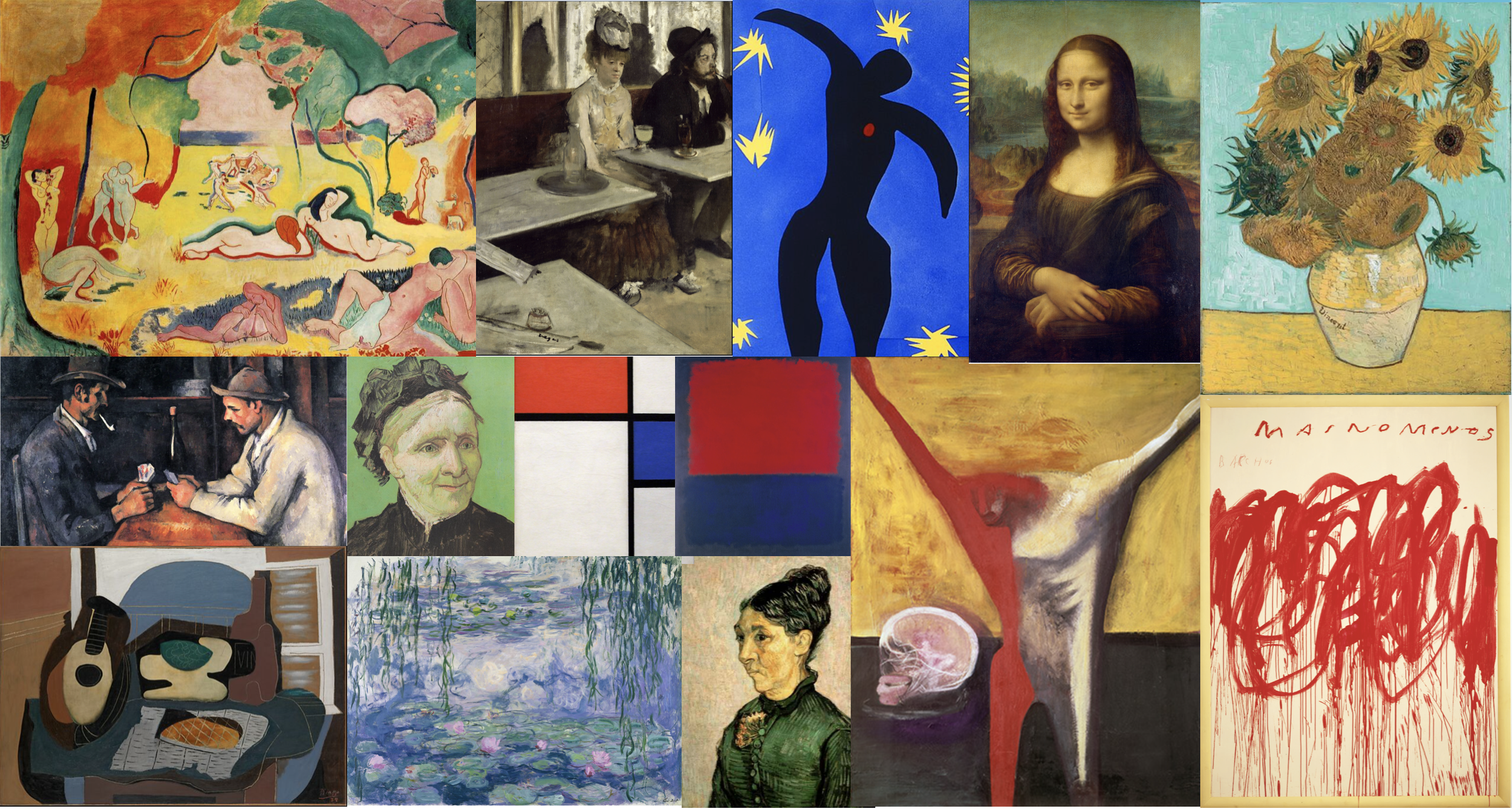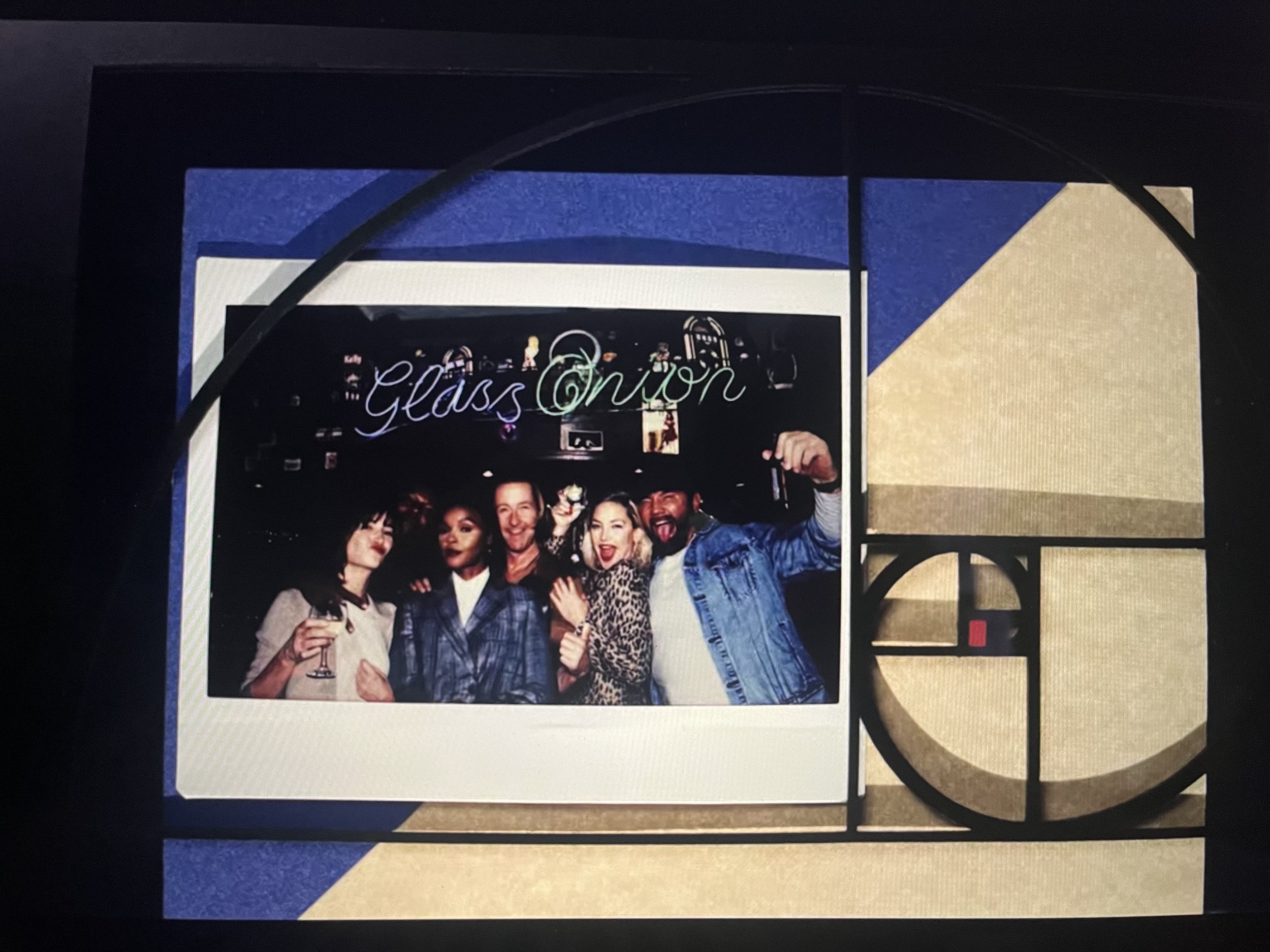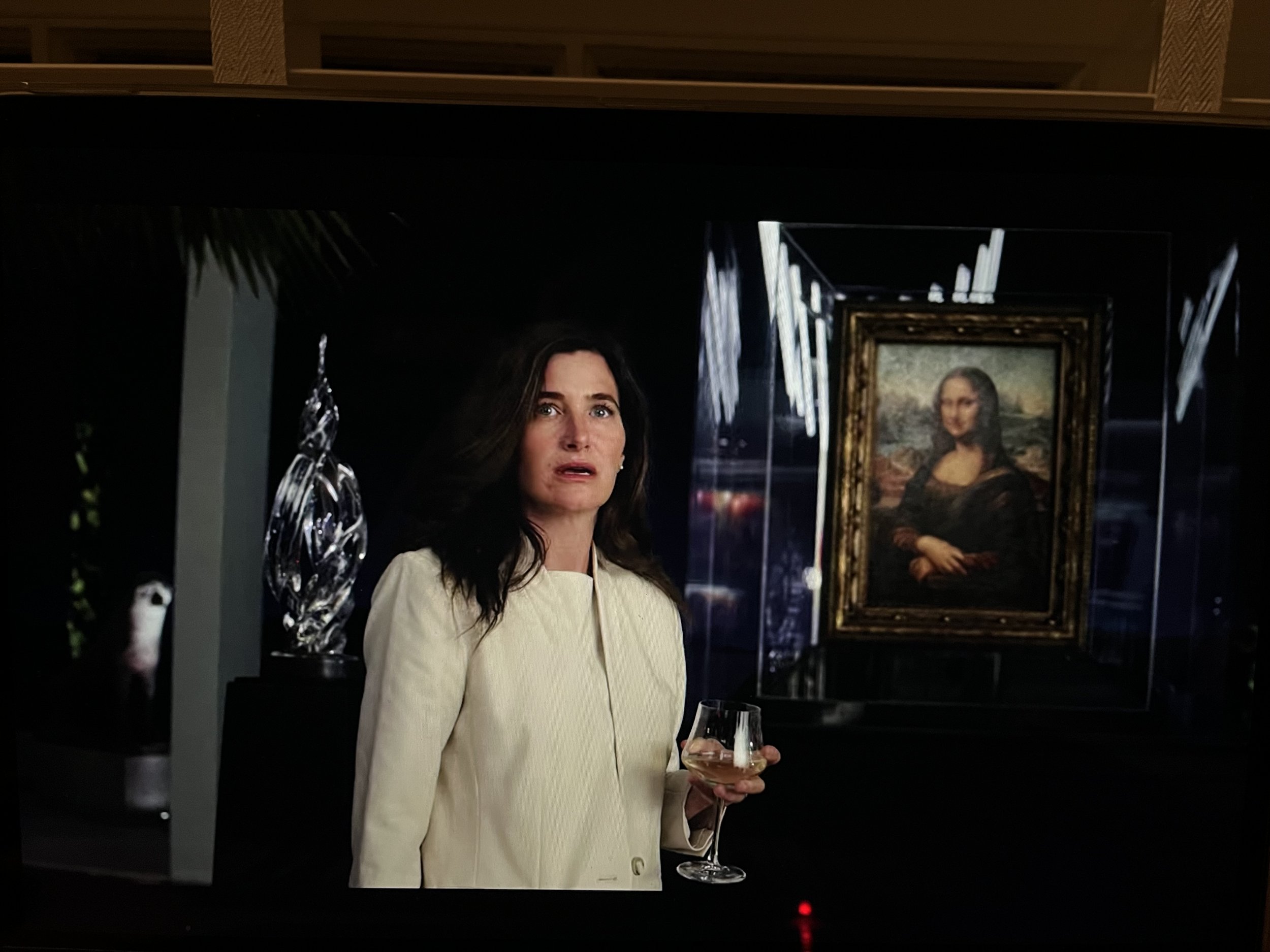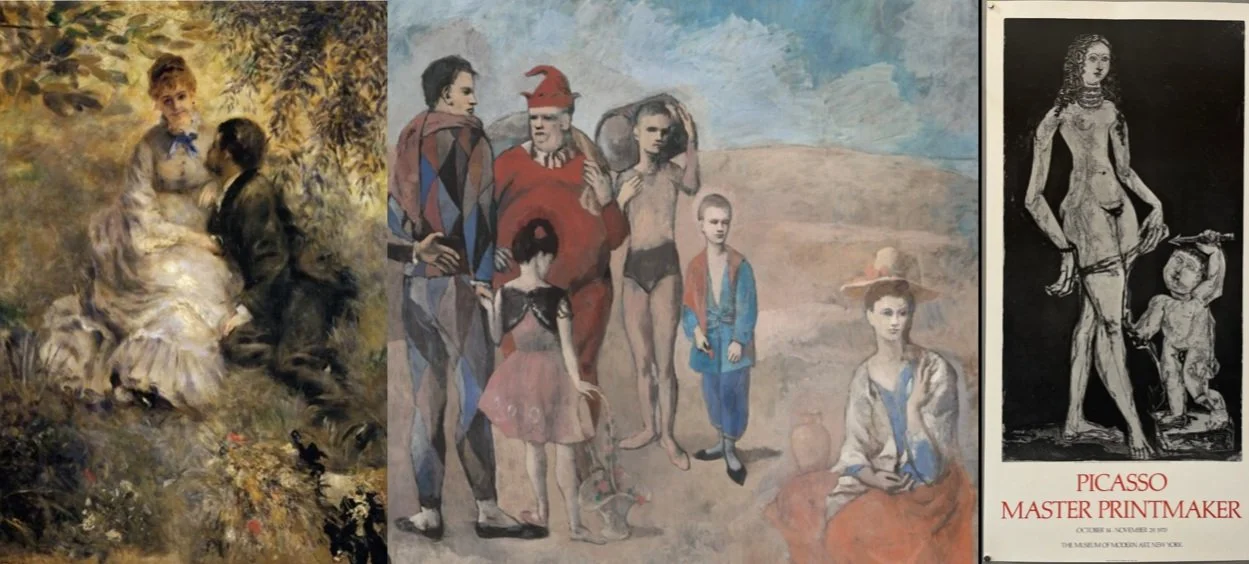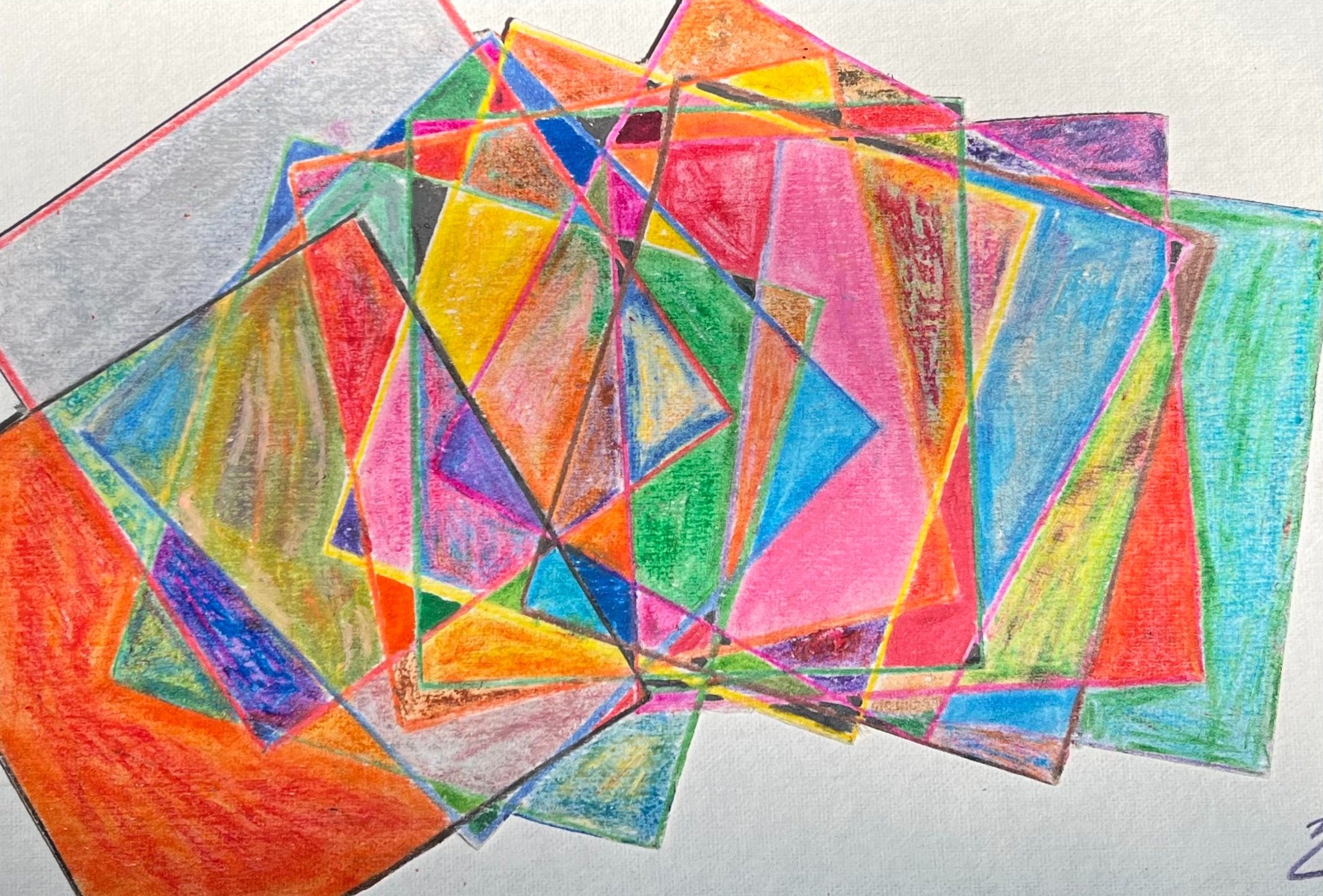Film Essay: The Art in "Glass Onion: A Knives Out Mystery"
I loved “Glass Onion: A Knives Out Mystery”. It was an exhilarating watch. The twists and turns were incredible. The screenplay was tight and brilliantly paced. The characters and the performances were impeccable.
I’d like to specifically talk about the fantastic production design and set decoration in this film. The art collection that’s on display in billionaire Miles Bron’s residence on his private island is astounding. Some of the biggest artists of the late 19th and 20th centuries are represented here. I’m talking Matisse, Picasso, Van Gogh, Monet., Twombly, Bacon and others. Most notably, he has the Renaissance masterpiece The Mona Lisa on display. The actual one!
Much like his constant name-dropping of famous people that he knows, his display of art is a embarrassment of riches meant to impress visitors and demonstrate his wealth. I’m specifically interested in analyzing the works in reference to the film itself. How do the paintings relate to the characters, props and plot?
What follows is my analysis of fourteen paintings that appear in the film that I have identified.
NOTE: I will be discussing SPOILERS in this blog post, so if you haven’t seen the film already, give it a watch and come back. I don’t want to spoil all the terrific twists and turns that this film has to offer.
“Le bonheur de vivre”, Henri Matisse (1905-6)
This is one of my favorite paintings by Matisse and also a landmark painting in the history of modern art. I was thrilled to see it in the film since I walked by it constantly when I worked as an Art Team Member at the Barnes Foundation in Philadelphia.
It depicts an insane burst of color and sensuality. I think it deftly represents Bron’s island and his idealized vision of success and fortune. The paradise of his Greek island resembles the pastoral scene in the Matisse. The sea is in the distance and the inhabitants are enjoying life and connecting with nature. On Bron’s island, nature blends with the architectural landscape. Areas feel like gorgeous Mediterranean rooms in botanical gardens (reminds me of the National Botanical Gardens in Washington D.C.). The relationship between Bron and Whiskey is very sexual, resembling the couple in the Matisse foreground.
In other words, without the murder, the weekend on the island may well have looked like this Matisse painting. People dancing around, lounging, kissing, playing instruments and enjoying themselves.
It makes a lot of sense that Bron would seek out this work. It is a landmark work in modern art. For bragging rights alone, his character would want to own this work and show it off.
“Le Bonheur de Vivre” in a bedroom in Bron’s residence behind Blanc (played by Daniel Craig).
“Untitled (Bacchus 1st Version IV) ” Cy Twombly (2004)
I recognized that this work was a Cy Twombly because I have seen his “Fifty Days at Illium” series at the Philadelphia Museum of Art. His style is distinct.
“Mainomenos” means “mad god” or “raving one”. Below the scrawled word on the left is the faint word “Bacchus”. Twombly did a large series of paintings inspired by Bacchus, the Roman god of agriculture and, famously, wine.
This work is significant to the film for a number of reasons. For one thing, the fact that "mainomenos” is written on the painting directly points to the character of Miles Bron. He is indeed a “mad god” on his island. He acts like a raving lunatic during the film. He kills Duke and attempts to kill Andi Brand (actually Helen) by shooting her with Duke’s gun. Previously he killed the real Andi (who used to be his good friend) and made it look like a suicide. He acts at moments like he is truly invincible and that his wealth and standing in the world will shield him from anything.
Secondly, the painting deals with alcohol, which is a massive plot point in the film. Miles kills Duke by putting pineapple juice in his whisky.
And thirdly, after Duke dies, the camera cuts to Miles sitting gobsmacked on the couch. Look at how the Twombly painting is arranged in the shot. The red paint lines, falling down the campus, surround Miles’s head like flowing blood. The Twombly work is the first clue in the film that Miles did it. He is, in this way, caught red handed.
Though not this exact work, a similar Twombly that also includes “mainomenos” on it went on sale by Sotheby’s in 2016. It sold for 15.4 million. So, it is not unheard of for Bron to have bought this work.
Miles (played by Edward Norton) caught red handed by Cy Twombly. You can also see a close up image of a Lichtenstein in the background of this shot too.
The exact painting in the series that is present in the film. Notice how the word “Bacchus” is scrawled so faintly on the left side. You can hardly see the text.
“Dans un café”, Edgar Degas (1875-6)
This is an iconic Degas. So atmospheric and heartbreaking. I recognized it immediately because freshman year of college I wrote an essay in my art history class on the representation of the drink absinthe in Impressionist paintings. This is a fantastic representation of the addictive nature of the drink and its effect on the human body. This painting is housed at the Musee D’Orsay in Paris.
This is another painting that centers around alcohol, once again connecting to the murder of Duke in the film. Not only that, but when we first see this painting, Helen is downing a ton of Jared Leto’s hard kombucha and getting drunk as a result. Color-wise, unlike the “bonheur de vivre”, this painting is muted and oppressive.
It is also in the bathroom, which is crazy from an art preservation perspective. This demonstrates Bron’s lack of interest in preserving his works for future generations. He is so focused on the immediate moment. It also shows his lack of passion for the paintings themselves, just seeing them as a social commodity.
You can see the Degas work behind Helens (who is played by Janelle Monáe). Also, interesting to note the use of reflection in this shot. The cafe in the painting has a mirror and we see the backs of the patron’s heads. In the bathroom in the film, we see a small mirror reflecting the magazine with Birdie’s face on the cover.
“Sunflowers”, Vincent Van Gogh (1888)
I love Van Gogh’s sunflower paintings. They are truly iconic. He painted seven canvases of sunflowers while in Arles in 1888/89. I find his sunflowers to be so expressive, each flower having its own personality. Bron has this specific sunflower painting in the sitting area of his house. It only appears fully for a few frames.
We never see a close up image of the work, but I am guessing that this is the sunflowers painting that is at the Neue Pinakothek in Munich. Van Gogh did a variation of that painting which is now at the Philadelphia Museum of Art, though looking even from a distance this appears to have the brighter spots in the background which matches up with the Munich sunflowers.
Keeping with the idea that Miles collects these works of art simply as a status thing, owning a Van Gogh sunflower painting is another art flex. I also think that the idea of a vase of flowers is fascinating. The flowers are dying, being kept alive so briefly by water. Even in this painting we see one of the flowers is wilted and dead. These flowers allude to an incoming death in the film (i.e. Duke’s). You could also think of the flowers relying on the water, just as the members of the “Shitheads” group rely on Miles for money.
Claire Debella (played by Kathryn Hahn) casually having a drink with a Van Gogh behind her.
“The Crucifixion”, Francis Bacon (1933)
This is an incredibly eerie work. In the foreground, a jellyfish-esque glowing skull floats while behind it an abstracted figure is crucified, half their body a blank red slate. I recognized this as a work by Bacon immediately because it reminded me of his “Three Studies for Figures at the Base of the Crucifixion” work.
This is actually in a private collection, which lines up nicely with the fact that Miles Bron owns it in the film. It was one of three crucifixion paintings that Bacon painted in 1933. He painted a number of others throughout his career.
I think that this painting points directly to the fact that Andi was symbolically crucified by her friends during the trial. They all lied and screwed her over. This betrayal set the course for her eventual death by Bron’s hand.
Notice once again the presence of red in this painting. The Twombly also employed that color. And the couch, lamps and even the rug in the main room of the Glass Onion are red as well. This presence of the color of blood also alludes to the death of Duke and the attempted murder of Helen. It could even allude to the fire that eventually destroys all these paintings.
Lionel Toussaint (played by Leslie Odom Jr.) with the Bacon work stalking him in the background.
Look at the ghostly outline of the figures face. And the sharp lines of their ribs. The iridescent skull that is see-through. It really sends a shiver down your spine.
“Water-Lilies”, Claude Monet (1916-19)
In the same sitting room as the Van Gogh sunflowers, we see this gorgeous water-lilies work by Claude Monet. It is significant that both are by recognizable artists and both are famous series that the artists embarked on during their careers. Monet painted around 250 water-lily canvas. As such, having a Monet water-lilies is an art flex that Bron wanted to show off.
This water-lilies work is at the Musée Marmottan Monet in Paris. I hadn’t seen it before and it is quite striking. I especially like the fact that it is unclear which way is up and which way is down. There is no sense of stability. For example, the leaves from the willow tree could also be seaweed floating upwards into the water. This connects to the fact that Bron’s island is a fantastical wonderland disconnected from reality. It feels like a fever dream. Like it isn’t real.
Blanc with his nifty swimming outfit (reminiscent of the early 20th century swimsuits that were worn while Monet was painting this painting.
“Portrait of the Artist’s Mother”, Vincent Van Gogh (1888)
This is the second Van Gogh to appear in this film. Bron has such an embarrassment of art riches that he puts this priceless work in what appears to be in the security office. It’s even out of its frame! This just shows the disregard that he has for the art in his possession.
Van Gogh painted it from a black and white photograph of his mother Anna Carbentus Van Gogh. He was living in the south of France at the time. His sister sent him the photograph and he decided to paint his mother because the black-and-white image annoyed him. In the end though, he wasn’t satisfied with the work. The color palette makes his mother look slightly ill. The green color is overpowering. This painting is at the Norton Simon Museum of Art in Pasadena.
In the film, the motherly figure appears to be looking directly at Lionel. Watching him coldly as he desperately tries to call for help. She is a practically a character in this scene. Smiling and unhelpful.
Anna staring at Lionel.
“Icarus”, Henri Matisse (1947)
This is one of the twenty images that Matisse created for his groundbreaking book “Jazz”. The entire book deals with mainly the theater and the circus. They are derived from paper cutouts, which was a medium that Matisse embraced late in life.
Bron hangs this work opposite the Degas in the bathroom. Blanc even mentions it earlier in the film saying “I can handle the Matisse in the bathroom but is that a…”. He interrupts himself here, but he could either be talking about the Degas, or the other Van Gogh. It is also appears that this is the original paper cut out by Matisse. You can see that the crease in the blue paper appears to be three-dimensional.
This Matisse work depicts the figure of Icarus flying through the stars, supposedly falling after crashing into the sun. This is emblematic of Bron’s position: he flew too close to the sun (i.e. resorting to killing Andi and then Duke) and is going to come crashing down like Icarus.
I love how Blanc’s outfit perfectly matches the colors in the Matisse. His yellow bandana matches with the stars and his blue stripes match with the sky.
“Portrait of Madame Trabuc”, Vincent Van Gogh (1889)
Van Gogh painted portraits of Madame Trabuc and her husband who was an attendant at Saint Paul Hospital in the south of France. He actually gifted the originals to both of the sitters so the this painting of Madame Trabuc is a copy that Van Gogh did of his own painting to give to his brother.
On the subject of Madame Trabuc, Van Gogh wrote to his brother on the 7th or 8th of September 1889 that “She is a faded woman, an unhappy, resigned creature of small account, so insignificant that I have a great longing to paint that dusty blade of grass”.
As for why this painting is in Bron’s house, I have a few guesses. For one thing, he is showing off his ridiculous collection of Van Goghs. He has so many that he can afford to put one in his bathroom. I also think that it is significant that Trabuc is described by Van Gogh as unhappy. Most of the people in the “Shitheads” group are unhappy in one way or another. For example:
Andi was unhappy that her friends betrayed her and her career was destroyed.
Lionel is unhappy that Bron doesn’t listen to him and his expertise.
Birdie is unhappy that her fame seems to be slipping away.
So while they mostly put on the facade that they were happy and carefree, really the characters in this film are deeply troubled. As I have previously mentioned, all the members of the “Shitheads” group are beholden to Miles. They rely on him and, in the case of Birdie, would happily ruin their reputation for him. Other people that are unhappy in the film include Helen (because her sister is dead) and Peg (who feels like if Birdie’s career tanks due to the sweatshop controversy, her’s will too because she’s Birdie’s assistant).
Finally, the whole scene in the bathroom centers around mirrors and reflections. This works perfectly with the idea that Helen is Andi’s twin sister. She is her reflection.
You can see Trabuc reflected in the mirror, a third character in this scene.
The real work is housed in the Hermitage in Saint Petersburg.
“The Card Players”, Paul Cézanne (1882-3)
This work can only be seen for a few frames in the film. It is located on the second floor of the main area in the Glass Onion building. You can seen it in the screen shot below in the upper right hand side of the image. I noticed it and immediately knew it was a Cézanne .
This card players was actually purchased by the country of Qatar in 2012 for a whopping $250 million. At the time this was the most amount of money paid for a work of art. There are only five card player paintings in the series, and the other four are in: The Barnes Foundation, The Musée D’Orsay, The Courtauld and the Metropolitan Museum of Art. The Qatar, D’Orsay and Courtauld paintings all look quite similar while the Met and Barnes works are far larger and contain more figures. The fact that this work is currently in a private collection and sold for that amount of money matches perfectly with the character of Miles Bron. In the world of the film, he probably purchased this work for $250 million dollars and then put it up in his house.
Also, notice the presence of alcohol in the painting. Once again we have a drink represented in the art in Bron’s house, connecting with the drink used to kill Duke.
You can see the card players in the upper part of this screenshot. This also shows an entire section of the room. You can see the Bacon on the right side. An ancient ruin on the left. Also notice all the glass sculptures scattered about.
A close up image of the card players. I highly suggest looking at the other works in the series. They are all terrific.
“Number 207 (Red over Dark Blue on Dark Grey)”, Mark Rothko (1961)
You can spot a Rothko from a mile away. His abstract, window-like paintings are truly awe-inspiring. I highly suggest visiting the National Gallery of Art in D.C. and going to their East Wing. On the top floor there is an entire room filled with Rothkos. In the Phillip’s Collection (also in D.C.) there is a small room dedicated to holding four Rothkos. Both places are incredibly calming.
The work that Miles owns has a dark grey background covered with a rectangle of bright red and a smaller rectangle of dark blue that almost blends into the background grey. The painting is currently at the Berkeley Art Museum. Notice once again the presence of the color red.
By the looks of it, Miles has not hung the painting in the correct orientation. This could show his disinterest in the art itself and an interest instead in the social standing that it brings. I think it also could be him saying that basically that he has the power to put up his art any way he likes. This egotistical, self-serving state of mind very much represents the character of Miles Bron.
In addition to the orientation of the work, there is another element of a Rothko that deftly describes the “Glass Onion” itself: The layers. When Miles talks about his love for “The Mona Lisa”, he says the following: “This simple thing you thought you were looking at takes on layers and depth so complex they give you vertigo.” This quote deftly describes “Number 207". Rothko’s paintings have a knack of entrancing the viewer because of the layers of paint and the subtle colors that seem to be hidden in the obvious colors.
And layers are a perfect way to describe a mystery. Peeling back the layers to find out who committed the crime.
Whisky (played by Madelyn Cline) giving the middle finger to Miles while the Rothko watches on.
“Still Life with Mandolin and Galette”, Pablo Picasso (1924)
This painting was a hard one to identify. It only appears for a few brief frames in the film, since it is in a hallway leading from the main room in the Glass Onion building. I initially identified this work as “Still Life with Stone” which is currently housed at the Abbot Hall Art Gallery in the UK. However, after later checking the image credits on the film, it turns out this is “Still Life with Mandolin and Galette”, painted the same year. It is housed at the Metropolitan Museum of Art. They are remarkably similar. It appears that “Still Life with Stone” is just a bit brighter in color.
It is a wonderful abstract still life with wine (there is another representation of alcohol again), a galette (almond paste tart) on newspaper, a mandolin and a window leading out to the sea. My guess would be that he painted this painting while in Juan-les-Pins in the south of France. This was where he painted “Mandolin and Guitar” in 1924. If you look at the work here on the Guggenheim website, you can see that they resemble each other quite closely.
If this is the case, then we are looking at a Mediterranean scene, not unlike the Greek coastline that surrounds Bron’s private island. Perhaps that is what drew him to purchase this painting.
If you look are the far right of this image, you can clearly see the round blond shape of the bowl, the mandolin and the arched windows.
“Composition No. II with Red and Blue”, Piet Mondrian (1929)
This is a classic Mondrian. His abstract works always remind me of city streets seen from above. This work contains the color red, as do a lot of works that I have discussed. Mondrians also strike me as filled with order and stability. Just think of the puzzle boxes that appear at the beginning of the film: They are entirely well though out, have no mistakes, are pleasing to look at and they open in one perfect manner. I feel that this Mondrian is the persona that Bron puts out to the world. Brilliant and no blemishes. Of course, that’s not true at all.
There is another appearance of a Mondiran-esque thing up in Bron’s office. In the glass work where he displays the Glass Onion picture from the glory days, we see a distinct red and blue dot with black lines and a white background. Very much like a Mondrian painting. Even more mind-blowing? The red dot is actually the red envelope that Andi hid the original napkin which laid out the plan for the Alpha company.
You can see the Mondrian on the far right side of this screenshot.
The red and blue rectangles appear again later in the film.
“The Mona Lisa”, Leonardo Da Vinci, (1503-6)
One of the most famous paintings in the world. Period. And Miles Bron got a short term loan from the Louvre to put it on display in his house. The fact that he has possession of “The Mona Lisa” is the ultimate art flex. He talks about how much he loves the painting. Says that when he saw if in person for the first time at six years old it changed his life. But really, in the end, it is all about his egotism. He has said for years that he wants “to be responsible for something that gets mentioned in the same breath as the Mona Lisa, forever.” It’w about social status. Becoming folklore. In the end, he gets his goal because he is the person that destroyed “The Mona Lisa”.
Miles also says something else about the Mona Lisa smile: “You know Da Vinci invented a technique for brushstrokes that leaves no lines? That's how her expression changes when you look straight at her, try it. Her smile disappears. Is she happy? Sad? Something else?” This idea of hiding your expression, not revealing all of your cards and being hard to read is critical in the mystery genre. Imagine how Blanc had to act early in the film, knowing that Helen was pretending to be her dead twin sister? And Helen had to literally be someone else and change her entire accent and mannerisms. They both needed to be impossible to read. Just like Mona Lisa’s expression.
Claire in absolute shock that she is in front of the real Mona Lisa.
This is a screenshot of the original “Mona List”. The fantastic painted replica of “The Mona Lisa” used in “Glass Onion” was painted by artist James Gemmill.
Conclusions
There are dozens of other paintings present in this film, I’ve just listed a few in this blog entry that stood out to me personally. Definitely look back at the film again and see if you can identify some other works. The production design team, headed by Rich Heinrichs, and the art department did a fantastic job decorating the Glass Onion residence set with artwork to represent Bron’s character and the major themes of the film.
Through analyzing the works in the blog entry, I can really see the care and thought that was taken to ensure that the paintings in the Glass Onion residence represented something larger than just the works themselves. Congrats to the entire cast and crew of Glass Onion: A Knives Out Mystery on a truly fabulous film.
If you’d like to read more about the art that is present in the film, the way that works were picked and replicated to be used on set and also some interviews with the production designer Rich Henrichs, here are a few articles to peruse: Artnet News, Netflix, Entertainment Weekly, Indiewire, Frederic Magazine.
In the end, all of the art is destroyed in a massive fire that Helen started. In this screenshot you can see the Rothko going up in flames, the Bacon ringed by fire and the Twombly almost entirely consumed. Miles is powerless now and just watches on as the destruction spreads.
Thanks for reading!
Nicholas
Some Links
Read More Of My “Art In Film” Blog Entries:
Check Out My Original Artwork:
Listen To My Music:

